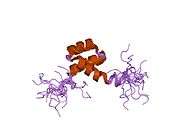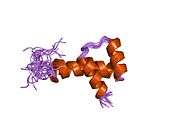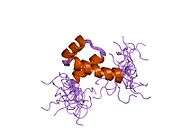HOXA7
Homeobox protein Hox-A7 is a protein that in humans is encoded by the HOXA7 gene.[5][6][7]
In vertebrates, the genes encoding the class of transcription factors called homeobox genes are found in clusters named A, B, C, and D on four separate chromosomes. Expression of these proteins is spatially and temporally regulated during embryonic development. This gene is part of the A cluster on chromosome 7 and encodes a DNA-binding transcription factor which may regulate gene expression, morphogenesis, and differentiation. For example, the encoded protein represses the transcription of differentiation-specific genes during keratinocyte proliferation, but this repression is then overcome by differentiation signals. This gene is highly similar to the antennapedia (Antp) gene of Drosophila.[7]
See also
References
- 1 2 3 GRCh38: Ensembl release 89: ENSG00000122592 - Ensembl, May 2017
- 1 2 3 GRCm38: Ensembl release 89: ENSMUSG00000038236 - Ensembl, May 2017
- ↑ "Human PubMed Reference:".
- ↑ "Mouse PubMed Reference:".
- ↑ McAlpine PJ, Shows TB (Aug 1990). "Nomenclature for human homeobox genes". Genomics. 7 (3): 460. doi:10.1016/0888-7543(90)90186-X. PMID 1973146.
- ↑ Scott MP (Dec 1992). "Vertebrate homeobox gene nomenclature". Cell. 71 (4): 551–3. doi:10.1016/0092-8674(92)90588-4. PMID 1358459.
- 1 2 "Entrez Gene: HOXA7 homeobox A7".
Further reading
- Balling R, Mutter G, Gruss P, Kessel M (1989). "Craniofacial abnormalities induced by ectopic expression of the homeobox gene Hox-1.1 in transgenic mice". Cell. 58 (2): 337–47. doi:10.1016/0092-8674(89)90848-9. PMID 2568891.
- Acampora D, D'Esposito M, Faiella A, et al. (1990). "The human HOX gene family". Nucleic Acids Res. 17 (24): 10385–402. doi:10.1093/nar/17.24.10385. PMC 335308. PMID 2574852.
- Boncinelli E, Acampora D, Pannese M, et al. (1990). "Organization of human class I homeobox genes". Genome. 31 (2): 745–56. doi:10.1139/g89-133. PMID 2576652.
- Verlinsky Y, Morozov G, Gindilis V, et al. (1995). "Homeobox gene expression in human oocytes and preembryos". Mol. Reprod. Dev. 41 (2): 127–32. doi:10.1002/mrd.1080410202. PMID 7654365.
- Apiou F, Flagiello D, Cillo C, et al. (1996). "Fine mapping of human HOX gene clusters". Cytogenet. Cell Genet. 73 (1–2): 114–5. doi:10.1159/000134320. PMID 8646877.
- Knoepfler PS, Calvo KR, Chen H, et al. (1998). "Meis1 and pKnox1 bind DNA cooperatively with Pbx1 utilizing an interaction surface disrupted in oncoprotein E2a-Pbx1". Proc. Natl. Acad. Sci. U.S.A. 94 (26): 14553–8. doi:10.1073/pnas.94.26.14553. PMC 25052. PMID 9405651.
- Min W, Woo HJ, Lee CS, et al. (1998). "307-bp fragment in HOXA7 upstream sequence is sufficient for anterior boundary formation". DNA Cell Biol. 17 (3): 293–9. doi:10.1089/dna.1998.17.293. PMID 9539109.
- McIlhatton MA, Bremner P, McMullin MF, et al. (1998). "Sequence characterisation and expression of homeobox HOX A7 in the multi-potential erythroleukaemic cell line TF-1". Biochim. Biophys. Acta. 1442 (2–3): 329–33. doi:10.1016/s0167-4781(98)00170-5. PMID 9804983.
- "Toward a complete human genome sequence". Genome Res. 8 (11): 1097–108. 1999. doi:10.1101/gr.8.11.1097. PMID 9847074.
- Dias Neto E, Correa RG, Verjovski-Almeida S, et al. (2000). "Shotgun sequencing of the human transcriptome with ORF expressed sequence tags". Proc. Natl. Acad. Sci. U.S.A. 97 (7): 3491–6. doi:10.1073/pnas.97.7.3491. PMC 16267. PMID 10737800.
- Kim MH, Jin H, Seol EY, et al. (2000). "Sequence analysis and tissue specific expression of human HOXA7". Mol. Biotechnol. 14 (1): 19–24. doi:10.1385/MB:14:1:19. PMID 10911612.
- La Celle PT, Polakowska RR (2001). "Human homeobox HOXA7 regulates keratinocyte transglutaminase type 1 and inhibits differentiation". J. Biol. Chem. 276 (35): 32844–53. doi:10.1074/jbc.M104598200. PMID 11435435.
- Kosaki K, Kosaki R, Suzuki T, et al. (2002). "Complete mutation analysis panel of the 39 human HOX genes". Teratology. 65 (2): 50–62. doi:10.1002/tera.10009. PMID 11857506.
- Strausberg RL, Feingold EA, Grouse LH, et al. (2003). "Generation and initial analysis of more than 15,000 full-length human and mouse cDNA sequences". Proc. Natl. Acad. Sci. U.S.A. 99 (26): 16899–903. doi:10.1073/pnas.242603899. PMC 139241. PMID 12477932.
- Scherer SW, Cheung J, MacDonald JR, et al. (2003). "Human chromosome 7: DNA sequence and biology". Science. 300 (5620): 767–72. doi:10.1126/science.1083423. PMC 2882961. PMID 12690205.
- Hillier LW, Fulton RS, Fulton LA, et al. (2003). "The DNA sequence of human chromosome 7". Nature. 424 (6945): 157–64. doi:10.1038/nature01782. PMID 12853948.
- Bertrand FE, Spengeman JD, Shah N, LeBien TW (2004). "B-cell development in the presence of the MLL/AF4 oncoprotein proceeds in the absence of HOX A7 and HOX A9 expression". Leukemia. 17 (12): 2454–9. doi:10.1038/sj.leu.2403178. PMID 14562113.
- Ota T, Suzuki Y, Nishikawa T, et al. (2004). "Complete sequencing and characterization of 21,243 full-length human cDNAs". Nat. Genet. 36 (1): 40–5. doi:10.1038/ng1285. PMID 14702039.
External links
- HOXA7+protein,+human at the US National Library of Medicine Medical Subject Headings (MeSH)
This article incorporates text from the United States National Library of Medicine, which is in the public domain.










